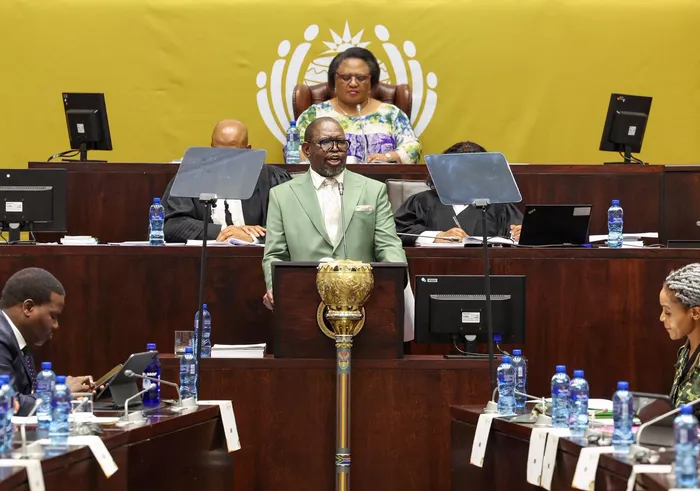Godongwana confident on debt stabilisation as fiscal consolidation gains momentum
MTBPS

Finance Minister Enoch Godongwana on Wednesday said the government remains on course to meet the fiscal targets set out in the February Budget.
Image: GCIS
Finance Minister Enoch Godongwana has assured the markets that South Africa is on track to restore fiscal sustainability, stabilise public debt, and improve spending efficiency, even in a challenging low-growth environment.
Delivering the 2025 Medium-Term Budget Policy Statement (MTBPS) on Wednesday, Godongwana said government remains committed to meeting the fiscal targets set out in the February Budget.
This is despite the public debt now expected to peak at 77.9% of GDP in the current fiscal year, slightly higher than the 77.4% estimated in May.
“I am pleased to inform the House and the country that we are on track to restore fiscal sustainability. Government debt will stabilise in 2025/26, at 77.9% of GDP,” Godongwana said.
“This is the first time since the 2008 financial crisis that public debt will not grow as a percentage of GDP.”
Godongwana said Treasury’s fiscal strategy remains anchored on stabilising debt, growing the primary budget surplus, and improving efficiency in public spending.
He added that fiscal policy will continue to channel more resources toward infrastructure investment to support long-term growth.
“Since 2008, spending has consistently exceeded revenue, driving up debt and debt-service costs. These costs crowded out spending on critical services and exerted pressure on lending rates across the economy. But we are now turning this around,” he said.
Treasury expects revenues to exceed budget estimates by R19.3 billion this year, while debt-service costs will be R4.8bn lower than projected.
After more than a decade of primary budget deficits, government recorded a primary surplus — where revenue exceeds non-interest spending, in 2023/24, a trend that is expected to continue and strengthen.
The surplus is projected to rise from 0.5% of GDP in 2023/24 to 2.5% in 2028/29, helping to stabilise and gradually reduce debt-service costs.
“We will also achieve a primary budget surplus of R68.5bn – or 0.9% of GDP – this year. This will grow to R224bn by 2028/29,” Godongwana said.
“The overall budget deficit will narrow from 4.5% of GDP in 2025/26 to 2.7% in 2028/29.”
Over the medium term, debt-service costs are expected to grow by only 3.8% annually, down sharply from the 7.4% projected in the February Budget, a signal of improving fiscal discipline.
Godongwana said government is also considering formalising a fiscal anchor to strengthen accountability and transparency in managing public finances.
“To further ensure long-term sustainability, we are exploring a principles-led approach that provides for clear parliamentary oversight, stronger reporting on fiscal risks, and transparency on distributional impacts,” he said. “Consultations with stakeholders and experts are ongoing.”
Economists on Wednesday welcomed fiscal discipline but warned of execution risks. They agreed that the finalisation of a fiscal anchor would mark a major step in restoring market confidence and ensuring long-term policy credibility.
Dr Elna Moolman, the head of South Africa macroeconomic research at Standard Bank Group, described the preservation of the debt-to-GDP peak this year as “the single most important feature” of the MTBPS.
“This is consistent with our long-standing view that government is committed to the planned fiscal consolidation,” Moolman said.
“The preservation of the debt-GDP peak this year should be positive for South Africa’s sovereign credit ratings insofar as it confirms government’s commitment to fiscal prudence.”
Moolman noted that while revenue for this year was lifted by nearly R20bn, medium-term revenue projections were not adjusted upwards.
She said the increased allocations for infrastructure, disaster rehabilitation, and key public institutions, including Transnet, the Border Management Authority, and Stats SA, were offset by savings from lower inflation, underspending, and the new Targeted and Responsible Savings (TARS) programme.
However, she cautioned that while S&P Global Ratings could upgrade South Africa’s rating during its upcoming review, Moody’s and Fitch are likely to maintain a cautious stance given weak growth and a still-high debt burden.
“The 2025 MTBPS sends a strong signal that government remains serious about fiscal consolidation. The challenge now is to maintain momentum, ensuring that spending discipline, reform progress, and stronger growth reinforce one another,” Moolman said.
Nedbank economist Isaac Matshego said the 2025 MTBPS showed “encouraging” progress in fiscal consolidation, with Treasury firmly committed to reducing the budget deficit and containing the rise in public debt.
“The main budget deficit narrows to below 3% of GDP by the final year of the MTEF, buoyed by faster revenue growth and slower expenditure increases,” Matshego said.
“However, execution risk remains high. Disappointments on the growth front would hurt revenue and weaken the fiscal trajectory.”
He added that although the fiscal metrics are improving, South Africa’s debt and deficit ratios remain above the median for ‘BB’-rated sovereigns, and refinancing risks persist due to large volumes of maturing loans.
“The confirmation of the lower inflation target is also welcome,” Matshego said. “It brings certainty to monetary policy and reduces tension between the National Treasury and the Reserve Bank.”
BUSINESS REPORT